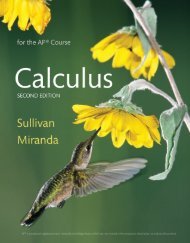SPA 3e_ Teachers Edition _ Ch 6
You also want an ePaper? Increase the reach of your titles
YUMPU automatically turns print PDFs into web optimized ePapers that Google loves.
448<br />
C H A P T E R 6 • Sampling Distributions<br />
Answers to <strong>Ch</strong>apter 6 Practice<br />
Test<br />
<strong>Ch</strong>apter 6<br />
Practice Test<br />
1. b<br />
2. c<br />
3. c<br />
4. b<br />
5. a<br />
6. a<br />
7. b<br />
Section I: Multiple choice Select the best answer for each question.<br />
1. A study of voting chose 663 registered voters at random<br />
shortly after an election. Of these, 72% said they<br />
had voted in the election. Election records show that<br />
only 56% of registered voters voted in the election.<br />
Which of the following statements is true about these<br />
percentages?<br />
(a) 72% and 56% are both statistics.<br />
(b) 72% is a statistic and 56% is a parameter.<br />
(c) 72% is a parameter and 56% is a statistic.<br />
(d) 72% and 56% are both parameters.<br />
2. Vermont is particularly beautiful in early October<br />
when the leaves begin to change color. At that time of<br />
year, a large proportion of cars on Interstate 91 near<br />
Brattleboro have out-of-state license plates. Suppose a<br />
Vermont state trooper randomly selects 50 cars driving<br />
past Exit 2 on I-91, records the state identified<br />
on the license plate, and calculates the proportion of<br />
cars with out-of-state plates. Which of the following<br />
describes the sampling distribution of the sample proportion<br />
in this context?<br />
(a) The distribution of state for all cars in the trooper’s<br />
sample of cars passing this exit<br />
(b) The distribution of state for all cars passing this exit<br />
(c) The distribution of the proportion of cars with<br />
out-of-state plates in all possible samples of 50 cars<br />
passing this exit<br />
(d) The distribution of the proportion of cars with<br />
out-of-state plates in the trooper’s sample of 50 cars<br />
passing this exit<br />
3. A polling organization wants to estimate the proportion<br />
of voters who favor a new law banning smoking<br />
in public buildings. The organization decides to<br />
increase the size of its random sample of voters from<br />
about 1500 people to about 4000 people right before<br />
an election. The effect of this increase is to<br />
(a) reduce the bias of the estimate.<br />
(b) increase the bias of the estimate.<br />
(c) reduce the variability of the estimate.<br />
(d) increase the variability of the estimate.<br />
4. A machine is designed to fill 16-ounce bottles of<br />
shampoo. When the machine is working properly, the<br />
amount poured into the bottles follows a normal distribution<br />
with mean 16.05 ounces and standard deviation<br />
0.1 ounce. Assume that the machine is working<br />
properly. If 4 bottles are randomly selected and the<br />
number of ounces in each bottle is measured, then<br />
there is about a 95% chance that the sample mean<br />
will fall in which of the following intervals?<br />
(a) 16.00 to 16.10 ounces<br />
(b) 15.95 to 16.15 ounces<br />
(c) 15.90 to 16.20 ounces<br />
(d) 15.85 to 16.25 ounces<br />
5. The central limit theorem is important in statistics<br />
because it allows us to use the normal distribution to<br />
find probabilities involving the sample mean if the<br />
(a) sample size is reasonably large for any population<br />
shape.<br />
(b) sample size is reasonably large and the population is<br />
normally distributed.<br />
(c) population size is reasonably large for any population<br />
shape.<br />
(d) population size is reasonably large and the population<br />
is normally distributed.<br />
6. At a high school, 85% of students are right-handed.<br />
Let X 5 the number of students who are right-handed<br />
in a random sample of 10 students from the school.<br />
Which one of the following statements about the<br />
mean and standard deviation of the sampling distribution<br />
of X is true?<br />
(a) m x 5 8.5; s x ≈ 1.129<br />
(b) m x 5 8.5; s x ≈ 0.113<br />
(c) m x 5 8.5; s x ≈ cannot be determined from the information<br />
given.<br />
(d) Neither the mean nor the standard deviation can be<br />
determined from the information given.<br />
7. The student newspaper at a large university asks an<br />
SRS of 250 undergraduates, “Do you favor eliminating<br />
the carnival from the end-of-term celebration?”<br />
In the sample, 150 of the 250 undergraduates are<br />
in favor. Suppose that 55% of all undergraduates<br />
favor eliminating the carnival. If you took a very<br />
large number of SRSs of size n 5 250 from this<br />
population, the sampling distribution of the sample<br />
proportion p^ would have which of the following<br />
characteri stics?<br />
(a) Mean 0.55, standard deviation 0.03, shape unknown<br />
(b) Mean 0.55, standard deviation 0.03, approximately<br />
normal<br />
(c) Mean 0.60, standard deviation 0.03, shape unknown<br />
(d) Mean 0.60, standard deviation 0.03, approximately<br />
normal<br />
Starnes_<strong>3e</strong>_CH06_398-449_Final.indd 448<br />
18/08/16 5:04 PMStarnes_<strong>3e</strong>_CH0<br />
448<br />
C H A P T E R 6 • Sampling Distributions<br />
Starnes_<strong>3e</strong>_ATE_CH06_398-449_v3.indd 448<br />
11/01/17 3:58 PM




